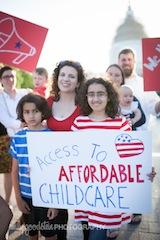
Both Moms and Children Benefit from Early Learning Opportunities
Today, the majority of moms with young children are working and high-quality child care and early learning opportunities can help them support their families. Nearly two-thirds (64.2 percent) of women with children under age six are in the labor force. The evidence is clear that high-quality early education is good for children. It’s indispensable for their mothers as well.
High-quality early learning and child care opportunities for children allow their mothers to get and hold a job. Moreover, parents can work more productively and effectively knowing that their children not only are in safe and healthy settings, but also getting a strong start. And when mothers are able to work, they can earn the income they need to support their families and provide resources that foster their children’s healthy development.
Yet, many families—particularly low-income families—struggle to afford even average-priced child care, much less higher-quality, and often higher-cost, high-quality child care. Average child care fees range from $3,700 to over $17,000 a year. A parent working full time at a wage of $10.50 per hour would have to spend nearly one-fifth to over three-quarters of her income to afford care for one child at these prices. These families need help affording high-quality early care and education—but such assistance is in short supply.
The major federal child care assistance program, the Child Care and Development Block Grant, fails to meet the need due to severe underfunding. In 2014, 363,800 fewer children received child care assistance than in 2006. A bipartisan reauthorization law in 2014 included many important provisions to improve both access to child care and the health and safety of child care. However, it wasn’t accompanied by the financial resources necessary to implement the reforms, much less serve the many families not currently receiving assistance.
Funding for high-quality prekindergarten is also insufficient to meet the families’ needs. As of 2015, state-funded pre-k programs and the federally funded Head Start program combined only served 13 percent of the nation’s three-year-olds and 38 percent of its four-year-olds. Only 52 percent of three- and four-year-olds not yet in kindergarten are enrolled in public or private preschool programs of any sort, with children in low- and moderate-income families less likely to be enrolled than children in higher-income families. Enrollment in state-funded preschool did increase modestly between the 2013-14 and 2014-15 school years, but families’ access to preschool is still far from adequate.
Mothers want to do what is best for their children, and for many that means working to better support their families, while making sure their children have the early learning opportunities they need to succeed in school. Investing in children and their families in the short- and long-term gives them both a fair shot to get ahead.
Americans realize the importance of investing in high-quality early care and education, for moms, children, families, and our country: in a recent poll, 88 percent of those surveyed said would be equally or more likely to support a candidate who committed to making expanding child care assistance and early education a priority. As we head into the 2016 election, politicians should take note.


The views and opinions expressed in this post are those of the author(s) and do not necessarily reflect those of MomsRising.org.
MomsRising.org strongly encourages our readers to post comments in response to blog posts. We value diversity of opinions and perspectives. Our goals for this space are to be educational, thought-provoking, and respectful. So we actively moderate comments and we reserve the right to edit or remove comments that undermine these goals. Thanks!